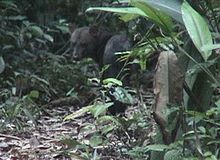Short-eared dog
| Short-eared dog | |
|---|---|
 |
|
| Scientific classification | |
| Kingdom: | Animalia |
| Phylum: | Chordata |
| Class: | Mammalia |
| Order: | Carnivora |
| Family: | Canidae |
| Subfamily: | Caninae |
| Genus: |
Atelocynus Cabrera, 1940 |
| Species: | A. microtis |
| Binomial name | |
|
Atelocynus microtis (Sclater, 1883) |
|
 |
|
| Short-eared dog range | |
The short-eared dog (Atelocynus microtis), also known as the short-eared zorro and small-eared dog, is a unique and elusive canid species endemic to the Amazonian basin. This is the only species assigned to the genus Atelocynus.
It has many names in the local languages where it is endemic, such as: cachorro-do-mato-de-orelha-curta in Portuguese, zorro de oreja corta in Spanish, nomensarixi in the Chiquitano language, and uálaca in Yucuna. Other names in Spanish are zorro ojizarco, zorro sabanero, zorro negro.
After the formation of the Isthmus of Panama in the latter part the Tertiary (about 2.5 million years ago in the Pliocene), canids migrated from North America to the southern continent as part of the Great American Interchange. The short-eared dog's ancestors adapted to life in tropical rainforests, developing the requisite morphological and anatomical features. Apart from its superficial resemblance to the bush dog, the short-eared dog seems not to be closely related to any fox-like or wolf-like canid. It is one of the most unusual canids.
Two subspecies of this canid are recognized:
The short-eared dog can be found in the Amazon rainforest region of South America (in Peru, Bolivia, Brazil, Colombia, Ecuador and possibly Venezuela). There is a single report of "three slender, doglike animals" of this species sighted in the Darien region of Panama in 1984 by German biologist Sigi Weisel and a native Embera nation Panamanian; this rare species' presence in Panama is possible because of "the continuous mass of forest habitat that covers this region". It lives in various parts of the rainforest environment, preferring areas with little human disturbance. It lives in both lowland forests known as Selva Amazónica and terra firme forest, as well as in swamp forest, stands of bamboo, and cloud forest.
...
Wikipedia

